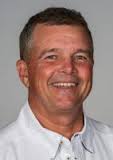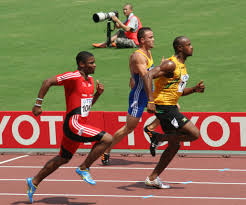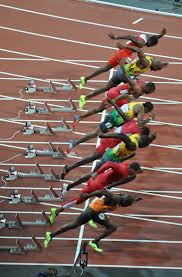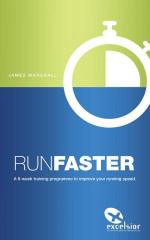Main Menu
Latest Blog Entry
User login
The fundamentals of acceleration mechanics
“I have spent my whole life devoted to writing 1 good programme”
 Vince Anderson, Texas A&M sprints coach at GAIN VII.
Vince Anderson, Texas A&M sprints coach at GAIN VII.
Coach Anderson was talking about his 100m speed training programme. His belief is that coaches only need to teach 1 model of sprint mechanics, get damn good at it, then add “subtle variations“when required, for example, in the 200 meters acceleration pattern or the 110 meter hurdles acceleration pattern
When dealing with athletes, he uses a basic language. All other patterns come from that. It is hard enough for athletes to get good at 1 model, let alone several different types.
So while we may look of “sport specific speed training” in reality it all comes down to acceleration training first, then application second.
The 100 meter acceleration pattern, because it requires maximal intensity, provides the aggressive pattern language necessary for coach and athlete to work from.
This seminar then concentrated on how his model works, and more importantly, how he coaches it.
Common Problems in 100 m sprint training
Anderson describes himself as a “reactive coach” he “coaches to the problem I see“. Here are some of the problems he encounters in sprinters and how he attempts to solve them.
- Too little body lean: they fail to push well or deep enough at the start. This causes them to come upright too early.
- Failing to continue to accelerate to maximal; IF they manage to get upright into a sprinting posture.
- Trying to claim territory: athletes step out, instead of stepping down. It should feel exactly like marching in place.
The 100m race is often broken down into phases for analysis. Whilst this may be useful for the coach to understand, it just adds complexity to the athlete. As Anderson says “My athletes can’t handle complexity“.
He describes the well run 100m as a holistic event. It is like a symphony or harmony without rhythm breaks. However, unlike an Orchestral movement, the 100m is a race of seamless aggression and smooth violence with big ranges of motion.
The start requires awareness and patience, it is easy to mistakenly use small quick actions. Instead think “The faster the run, the longer the push“.
“Don’t let the smooth taste fool you; sprinters have to work so much harder than they think.”
One anecdote Anderson related was of one of his athletes putting effort into a training run and exclaiming “I’m exhausted“! Well, the 100m is a maximal effort event: it should be tiring.
He uses “Acceleration” and “pushing” interchangeably as part of his coaching vernacular. Whilst it is impossible to accelerate for the whole race, you can PUSH for the whole race.
Anderson uses a visualisation technique of gently ascending lines, which then rise to vertical. The athlete thinks about this before training. He then places a cone at 30m and the athlete has to get to vertical at this point. By using a referential cue like this, the athlete gets used to doing things longer and harder.
When they get upright they have to think “PUSH DOWN“.
Coaching Cues for the 100 metre race
Anderson has developed some very clear coaching cues he uses with athletes. The Intent is to develop consistency on 4 fronts:
- Maximum velocity mechanics (run tall).
- Acceleration (pushing the whole race).
- Completion runs (blending the two).
- Apply to every run (pattern development).
Intent is everything in this race. “Any kid that can step down with extreme prejudice and get tall can run faster. It’s not a talent issue.”
(I hope P.E. teachers out there are paying attention: ANY kid can run faster).
The classic over reaching/ over striding that is seen is called “Casting” by Anderson. This leads to a longer ground contact time and therefore slower speed. Placing the foot down under the hip each time is the solution.
A 400m runner or half miler still have the same running mechanics: they still step down. But, they step down less hard, so the thigh recovers lower.
Things to avoid include:
The step out, cast foot, cast and grab or a “small, choppy stride“. Part of the problem is that athletes (and coaches) misinterpret the classic A/B drills as technical drills instead of the strengthening drills which was their original purpose.
Anderson called sprinting “The second worst culture in athletics, behind basketball“! Every element of the culture enables bad things to be done. It enables lack of modern thinking and “reinforces street mythology, ancient history and bad information.”
As a result, athlete use context as “an excuse to stay in dysfunction“. It is the coaches job to fix this.
“Good posture always wins”
 (Declaring confirmation bias here, as I always tell my athletes the importance of good posture: “Turn up, try hard, stand tall“).
(Declaring confirmation bias here, as I always tell my athletes the importance of good posture: “Turn up, try hard, stand tall“).
According to Anderson, running is:
- A series of precisely intentional ground strikes.
- The sworn enemy of landing or striding.
- The opposite of striding.
He uses a series of postural drills against a wall for his athletes to help develop. Anderson calls the position coming out of the start the “Post” as in “straight as a fence post“ (I refer to it as SLX: Straight Line Acceleration, adapted from Jack Blatherwick).
(Frans Bosch had made similar points 2 years previously at GAIN about running posture).
Getting out of the blocks
 Anderson trains his sprinters on Acceleration from Day 1(remember Accn= pushing) and he teaches them to apply this on every run. That way they are developing a pattern.
Anderson trains his sprinters on Acceleration from Day 1(remember Accn= pushing) and he teaches them to apply this on every run. That way they are developing a pattern.
Coming out of the blocks is like a “shock jump“; the harder you push from the blocks, the longer it takes to come up into an upright posture.
This harder push causes a more acute post position (SLX) which is only effective if the athlete has the ability to maintain this posture throughout.
The athlete should continue to “push through the post”. This requires concentration and keeping the shoulders up.
If the shoulders are down and you push hard, you fall over. “Force can’t turn a corner” so if you bend at the hips, you limit force application.
“Acceleration never, ever stumbles.”
Anderson then spent some time looking at the start position and showed a great picture using an equilateral triangle superimposed over the correct position for an athlete to get into the set position. This is an inherently stable position from which to start.
For field sports athletes, a 3 point stance can be used to achieve the same position. Jevon Kearse does this well (he is also a “super, foul tempered, aggresive athlete”).
Many athletes that Anderson sees struggle with the start from the blocks. “The problem is NOT that we athletes that have too great a spatial awareness“. Every decision he makes as a coach is designed to make it easier for the athlete to know where their body is.
He sometimes starts athletes from a Post position with his hands on their shoulders, to eliminate the problem with the rise. Keeping the head in a neutral position is also a useful cue.
“Try to avoid all stylistic tendencies. I use common sense.”
Summary
It was very refreshing to hear a coach of this standard say things like “our job is to make everyone better“, “coach without judgement” and “coach your ass off on their behalf“.
I have seen several track and field coaches “cherry pick” athletes from other schools or training groups who could already run fast. But, one of the joys of coaching is to be able to coach the process, rather than just get the result.
Coach Anderson exemplifies a coach who is striving to get the best from ALL his athletes, and also himself. He turned up to Gary Winckler’s practical session in the gym the day before to learn: another sign of a great coach.
 I have already applied some of these coaching cues in my speed training sessions, with the athletes responding well.
I have already applied some of these coaching cues in my speed training sessions, with the athletes responding well.
Recommended highly.
Further Reading
- Force, power and acceleration: thoughts from Jack Blatherwick.
- How can I sprint quicker?: 7 key areas to work on.
- Run Faster Book
Client Testimonials
 Blundells School
Blundells School
James has a huge breath and depth of knowledge on fitness issues. He is able to implement this knowledge into a practical course both making the task of fitness and conditioning both different and interesting from other fitness training that most are familiar with. He understands the safety issues when dealing with young adults strength and conditioning programmes. Programmes he sets are tailored to the individual needs of the group. There was a huge amount of progress made with some of these individuals in terms of their understanding of fitness and their own fitness levels.
More

